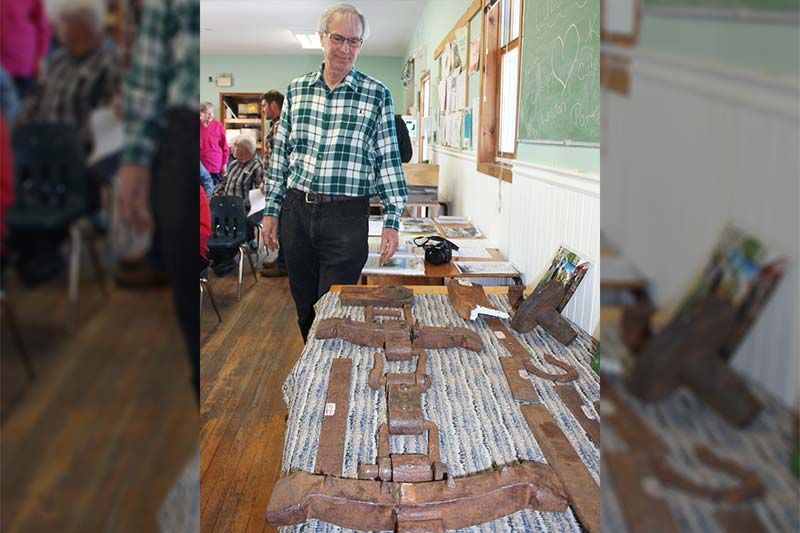Craig Bakay | Apr 25, 2018
Historical author Steven Manders (The First Spike) is pretty sure he can set to rest claims that the Gilmour Tramway was built in the 1850s.
Speaking to the Cloyne and District Historical Society Monday afternoon, Manders said: “I’ve found the original hand-written deed,” he said. “David Gilmour bought five acres of land for $45 from David Weese on April 17, 1882.
“Gilmour couldn’t have built the tramway on land he didn’t own at the time.”
From there, Manders went on to spin a fascinating tale of lumber wars in late 19th Century southern Ontario.
Manders has spent considerable time in the bush with a metal detector, ferreting out the paths of ‘ghost railways’ from the past including the K & P.
Along the way, he’s found a number of interesting things, including evidence of the Gilmour Tramway, which allowed pine logs from around Lake Mazinaw and area to find their way to Gilmour’s huge sawmill in Trenton,
“The Gilmour Mill could process a million board-feet of lumber per day,” Manders said. “That’s a huge capacity, even by today’s standards.
“It was the biggest sawmill in Canada but the problem was getting logs.”
Now, according to Manders, the Gilmours and others had already cleaned out most of the lumber available along the Moira and Trent River systems when they started to eye the trees in this area.
However, there was a problem in that there was no connected water system that could get the logs into the Moira River to be sent down to Belleville and eventually Trenton.
That’s when they came up the tramway and ‘jackladder’ system which would allow them to move logs up some 80 to 90 feet in elevation and 1.7 kilometres through the bush and eventually into the Skootamatta River which connects to the Moira.
Manders has found pieces of flywheel, steel strapping (which would have been placed on the wooden tramway), chain, various pieces for securing logs and draught horse gear which has been buried for decades while gradually piecing together the story.
“That’s the nice about the Canadian Shield,” he said. “You can still find things here whereas in western Ontario, things have been built over.”
Manders’ display, including a model of the tramway, will be on permanent display at the Cloyne Pioneer Museum & Archives, which opens June 23 with a barbecue.
More Stories
- Limestone Student Achievers
- North Frontenac wins grant sweepstakes and will upgrade Clar Mill Rink
- Back Forty Artisan Cheese Presents the 8th Annual “Curds and Cooks” Summer Festival
- The Mississippi Land Trust is Working Hard to Acquire 2 New Properties In North Frontenac
- Sydenham Lake Canoe Club Places at Ontario Team Trials
- Battery Energy Storage Coming To North Frontenac
- The Kashwakamak Lake Association AGM
- Choosing Collaboration Over Division
- The Roar
- South Frontenac Council - Elements Outdoors Rezoning And Mayor Miffed Over Orser Road Calming

